
A previous post, Community-based regeneration in semi-arid north Rajasthan, India (Mark Everard, 23 Nov 2015) reported on community-based initiatives creating rainwater-harvesting structures to intercept monsoon run-off and the social infrastructure necessary to achieve it.
Rajasthan’s human population is substantially dependent on groundwater. State centralisation of water ownership and management has led to abandonment of centuries-old localised water management techniques and community governance arrangements reflecting adaptations to climatic conditions. Successes at village and catchment scales across Alwar District, substantially driven by the NGO Tarun Bharat Sangh (TBS), have made serious contributions to the livelihoods of local people, recovery of groundwater and ecosystems, and reversal of prior cycles of socio-ecological degradation.

Tilda, in the Sarsa catchment
A visible consequence of catchment recharge has been the reemergence of perennial surface waters in the Arvari, Sarsa, Baghani-Teldehe and upper reaches of the Ruparel and Jahajwali, and their colonisation by a range of aquatic organisms. Many of these are obligate aquatic taxa, including hydrophytes (water plants), frogs, fish, terrapins, water-dependent birds (pied kingfishers, little cormorants and grey herons) and a variety of invertebrates (water snails, dragonflies, pond skaters and waterboatmen).
Virtually all species recorded by rapid ecological assessments of water bodies retained behind the eleven water management structures across the Arvari, Sarsa and Baghani catchments have local significance in Ayurvedic (traditional herbal) medicine, spiritually and also some non-market uses, for example:
- Almost all water plants have Ayurvedic applications for the stomach, the brain, halting bleeding and suppressing pain.
- All birds have symbolic roles in culture and religion, linked to the holy bird Garuda (assumed to be an eagle but embodied in all birds). All bird species and their songs have specific meanings, for example the peacock (the vahana, or vehicle, of the God Karthikeya and also the inspiration for traditional dances) and the black-headed ibis (perceived as taking harmful things from the soil, black soils and black birds imbued with particular spiritual significance).
- Fishes have generic significance, the goddess Shiva taking the form of the fish Matsya in her first incarnation. Fish are commonly associated with temples, where they are protected and often tamed and fed at temple ghats (steps to the water) for their Dharadi (connection with the gods) as is now the case at the temple on the restored Tilda water body.
- Various invertebrates have specific meanings, for example emergence of water snails during the monsoon is symbolic of the completion of life cycles, and dragonflies and damselflies are generally locally referred to as ‘helicopters’ particularly by children.

Tilda water body, swimming with the fishes that now abound there
Cultural ecosystem services (generally non-material benefits people obtain from ecosystems) and other primarily non-market ecosystem services (locally significant medicinal, symbolic and decorative resources) are commonly overlooked in ecosystem management. Yet they may be highly significant to local people, whose values and value systems are thereby omitted from decision-making. Local people are not merely passive beneficiaries, but key players in ecosystem use and management. Culture shapes the ways in which nature is perceived and valued, values often incommensurable with monetisation methods deployed in traditional decision-making. Yet non-material values can create strong ties between humans and their natural surroundings, constituting powerful incentives for people to engage with environmental conservation and often therefore constituting a key determinant of scheme success.
Linked socio-environmental regeneration reviewed in Community-based regeneration in semi-arid north Rajasthan, India addressed an impressive scale of socio-economic recovery achieved through regeneration of catchment ecosystems, though metrics observed (groundwater, cropping, forest cover, income, etc.) were largely utilitarian and omitted recovery of biota with less tangible cultural meaning. Yet recolonisation across formerly desertified catchment ecosystems by water-dependent organisms is significant in reviving a range of formerly ‘lost’ medicinal, spiritual and other cultural co-benefits of value and meaning to local people. These co-benefits provide a sense of place, identity, aesthetic and recreational values that collectively engender custodianship, mobilising local communities to regenerate ecosystem integrity, functioning and resilience across whole catchments and thereby to increase water, food and livelihood security. Policy reform is needed to improve coherence between high-level management goals and localised traditional practices and values, adapted to local climatic conditions over centuries, regenerating water systems locally and across whole catchments.
A peer-reviewed paper analysing co-benefits for cultural meaning and value deriving from catchment regeneration in semi-arid north Rajasthan has been published:
- Everard, M. (2016). Community-based groundwater and ecosystem restoration in semi-arid north Rajasthan (2): reviving cultural meaning and value. Ecosystem Services, 18, pp.33-44. DOI: 10.1016/j.ecoser.2016.01.007.
